
Speakers at the Nordic Air Cargo Symposium have said disruption in the industry is set to continue. The supply-demand balance in the air cargo market is expected to return to pre-COVID levels in 2025 although the prediction is complicated by several conditions.
Cargo capacity is projected to reach 2019 levels around 2023 but demand will continue to rise while the imbalance in supply and demand will persist until around 2025, said Lufthansa Cargo chief commercial officer Ashwin Bhat.
Bhat said the air cargo market would continue to benefit from ongoing container port congestions, rise in e-commerce demand and disruption in supply chains.
Nearshoring is not expected to impact the market he said, because “business is global, not local – we have to accept it”.
Kales Group chief executive Sebastiaan Scholte said the cost-of-living crisis could restrain consumer spending on products. This will have a negative effect on demand which could affect the industry.
TIACA director general Glyn Hughes pointed out that higher interest rates could benefit the air cargo market. “As interest rates go up, the cost of capital and the cost of the cargo sitting on ships for 60-80 days is very expensive to finance which will increase demand for air cargo,” he said.
Air cargo demand was up 7.1% in 2021 compared against 2019. In 2022, capacity is 5% lower versus 2019 levels, Seabury Cargo commercial director Jonathan Mellink said.
When asked when an equilibrium could be reached between demand and capacity, Mellink said it was very hard to predict given the current uncertainties in the market.
“When exactly air cargo will be in sync, it could be 2025ish but nobody really knows, especially nowadays because the world is changing every other week.
There is also big difference per region. Trans-Atlantic will look very different compared with intra-Asia, or Trans-Pacific, or intra-Americas.
It will look very different depending on the trade portfolio and the commodities being traded and on the return of passenger demand,” Mellink said.
Source: Air Cargo News